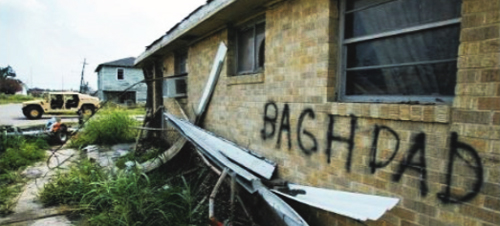This investigative history examines the consequences of war and securitization after 9/11 for US disaster preparedness, using the example of the post-Hurricane Katrina catastrophe in New Orleans and the Gulf Coast. While commonly understood as separate events, the “war on terror” and Hurricane Katrina were deeply entwined, from the siphoning away of natural disaster resources from FEMA for anti-terrorist purposes, to the militarization of post-disaster rescue, relief and security. In weaving these stories together, the piece raises broader questions about the relationship between global military projection and “domestic” well-being.
Slate, September 7, 2016
Something about walking naked through the ruins of St. Bernard Parish at 2 in the morning helped Tech Sgt. Mickey Giovingo leave Iraq. Since returning from war, he had slept in his car in the driveway of his smashed, cream-colored ranch house, in his uniform—the only clothing he had. He remembers sitting out there at night, thinking, “There are more noises at night in the desert than here.” He was hypervigilant, startling at the smallest sounds. Sometimes, he went out on patrol. He’d hear a car pull up and head over to confront the driver; copper thieves were ransacking abandoned houses, tearing out their plumbing.
He says he never threatened them but told the invaders to leave or he’d call the police. He always took along the gun he’d bought as soon as he arrived home, tucked behind his back. “A combat-mode kind of thing,” he said. One night, the isolation felt unbearable, and he had an idea. He took off his clothes, put on his tennis shoes, and went out into the devastation. He’d been subject to military discipline for months. He’d lost everything. Walking up the street stripped bare, he at last felt under his own command. When else could he do this without getting thrown in jail? “It was freeing,” he said.
Giovingo deployed to Iraq on Aug. 29, 2005, the same day Hurricane Katrina made landfall in Louisiana. Raised in midcity, he had a gift for electronics and had entered the Air Guard’s engineering and installation unit, wiring military facilities in Louisiana and then in the Middle East. He had been in Al-Udeid, Qatar, the night the storm neared shore. He flew to a base in Kirkuk the next morning. Over the next awful days, he and other guardsmen from the Gulf Coast kept close to the projection TVs in the dining hall. They saw the storm strike and the levees crumble and listened to reports of looting and chaos.
“I knew my house was gone,” he recalled. Giovingo had served as the Guard’s liaison to St. Bernard and knew its telecom system well; communication lines out of the parish had gone silent. It took him nearly a month, jockeying with others for internet time, to confirm that his family was safe. Meanwhile, he continued the dangerous work of laying cable along a trench in the base’s airstrip with his team. “You’re worried about rockets and mortars coming in … ” he said, “and then at night, you’re like, ‘What am I going to do when I get back?’ ”
Giovingo faced a hard choice. The soldiers of the 256th, an infantry brigade of the Louisiana National Guard, had been scheduled to rotate out at the end of September, and the guard decided to speed them home, to reunite them with their families and allow them to be on hand for recovery work. Giovingo was part of a separate unit, but the guard found seats for him and four members of his team on the return flight. He asked his colleagues if they should take the Page 3 of 29 offer; his colleagues deferred to him. He decided to stay. He was committed to finishing what he’d started, and he’d need combat pay—$225 extra per month— to help him rebuild in New Orleans. His sister told him about a Federal Emergency Management Agency aid program, and he got through to the agency despite his tight phone time allotment. You’re deployed? Not eligible. “How far do I have to deploy, I mean evacuate, to get money?” he asked himself. “I felt like I was in no-man’s land and forgotten.”
